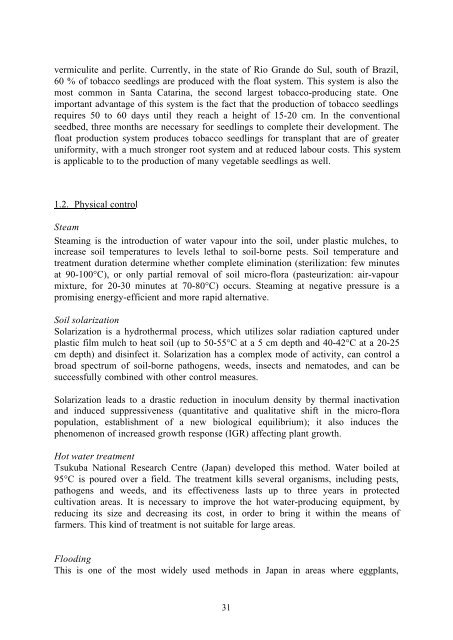Manual for Training of Extension Workers and Farmers on ... - DTIE
Manual for Training of Extension Workers and Farmers on ... - DTIE
Manual for Training of Extension Workers and Farmers on ... - DTIE
Create successful ePaper yourself
Turn your PDF publications into a flip-book with our unique Google optimized e-Paper software.
vermiculite <str<strong>on</strong>g>and</str<strong>on</strong>g> perlite. Currently, in the state <str<strong>on</strong>g>of</str<strong>on</strong>g> Rio Gr<str<strong>on</strong>g>and</str<strong>on</strong>g>e do Sul, south <str<strong>on</strong>g>of</str<strong>on</strong>g> Brazil,<br />
60 % <str<strong>on</strong>g>of</str<strong>on</strong>g> tobacco seedlings are produced with the float system. This system is also the<br />
most comm<strong>on</strong> in Santa Catarina, the sec<strong>on</strong>d largest tobacco-producing state. One<br />
important advantage <str<strong>on</strong>g>of</str<strong>on</strong>g> this system is the fact that the producti<strong>on</strong> <str<strong>on</strong>g>of</str<strong>on</strong>g> tobacco seedlings<br />
requires 50 to 60 days until they reach a height <str<strong>on</strong>g>of</str<strong>on</strong>g> 15-20 cm. In the c<strong>on</strong>venti<strong>on</strong>al<br />
seedbed, three m<strong>on</strong>ths are necessary <str<strong>on</strong>g>for</str<strong>on</strong>g> seedlings to complete their development. The<br />
float producti<strong>on</strong> system produces tobacco seedlings <str<strong>on</strong>g>for</str<strong>on</strong>g> transplant that are <str<strong>on</strong>g>of</str<strong>on</strong>g> greater<br />
uni<str<strong>on</strong>g>for</str<strong>on</strong>g>mity, with a much str<strong>on</strong>ger root system <str<strong>on</strong>g>and</str<strong>on</strong>g> at reduced labour costs. This system<br />
is applicable to to the producti<strong>on</strong> <str<strong>on</strong>g>of</str<strong>on</strong>g> many vegetable seedlings as well.<br />
1.2. Physical c<strong>on</strong>trol<br />
Steam<br />
Steaming is the introducti<strong>on</strong> <str<strong>on</strong>g>of</str<strong>on</strong>g> water vapour into the soil, under plastic mulches, to<br />
increase soil temperatures to levels lethal to soil-borne pests. Soil temperature <str<strong>on</strong>g>and</str<strong>on</strong>g><br />
treatment durati<strong>on</strong> determine whether complete eliminati<strong>on</strong> (sterilizati<strong>on</strong>: few minutes<br />
at 90-100°C), or <strong>on</strong>ly partial removal <str<strong>on</strong>g>of</str<strong>on</strong>g> soil micro-flora (pasteurizati<strong>on</strong>: air-vapour<br />
mixture, <str<strong>on</strong>g>for</str<strong>on</strong>g> 20-30 minutes at 70-80°C) occurs. Steaming at negative pressure is a<br />
promising energy-efficient <str<strong>on</strong>g>and</str<strong>on</strong>g> more rapid alternative.<br />
Soil solarizati<strong>on</strong><br />
Solarizati<strong>on</strong> is a hydrothermal process, which utilizes solar radiati<strong>on</strong> captured under<br />
plastic film mulch to heat soil (up to 50-55°C at a 5 cm depth <str<strong>on</strong>g>and</str<strong>on</strong>g> 40-42°C at a 20-25<br />
cm depth) <str<strong>on</strong>g>and</str<strong>on</strong>g> disinfect it. Solarizati<strong>on</strong> has a complex mode <str<strong>on</strong>g>of</str<strong>on</strong>g> activity, can c<strong>on</strong>trol a<br />
broad spectrum <str<strong>on</strong>g>of</str<strong>on</strong>g> soil-borne pathogens, weeds, insects <str<strong>on</strong>g>and</str<strong>on</strong>g> nematodes, <str<strong>on</strong>g>and</str<strong>on</strong>g> can be<br />
successfully combined with other c<strong>on</strong>trol measures.<br />
Solarizati<strong>on</strong> leads to a drastic reducti<strong>on</strong> in inoculum density by thermal inactivati<strong>on</strong><br />
<str<strong>on</strong>g>and</str<strong>on</strong>g> induced suppressiveness (quantitative <str<strong>on</strong>g>and</str<strong>on</strong>g> qualitative shift in the micro-flora<br />
populati<strong>on</strong>, establishment <str<strong>on</strong>g>of</str<strong>on</strong>g> a new biological equilibrium); it also induces the<br />
phenomen<strong>on</strong> <str<strong>on</strong>g>of</str<strong>on</strong>g> increased growth resp<strong>on</strong>se (IGR) affecting plant growth.<br />
Hot water treatment<br />
Tsukuba Nati<strong>on</strong>al Research Centre (Japan) developed this method. Water boiled at<br />
95°C is poured over a field. The treatment kills several organisms, including pests,<br />
pathogens <str<strong>on</strong>g>and</str<strong>on</strong>g> weeds, <str<strong>on</strong>g>and</str<strong>on</strong>g> its effectiveness lasts up to three years in protected<br />
cultivati<strong>on</strong> areas. It is necessary to improve the hot water-producing equipment, by<br />
reducing its size <str<strong>on</strong>g>and</str<strong>on</strong>g> decreasing its cost, in order to bring it within the means <str<strong>on</strong>g>of</str<strong>on</strong>g><br />
farmers. This kind <str<strong>on</strong>g>of</str<strong>on</strong>g> treatment is not suitable <str<strong>on</strong>g>for</str<strong>on</strong>g> large areas.<br />
Flooding<br />
This is <strong>on</strong>e <str<strong>on</strong>g>of</str<strong>on</strong>g> the most widely used methods in Japan in areas where eggplants,<br />
31
















